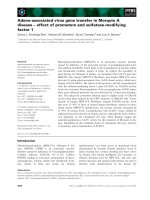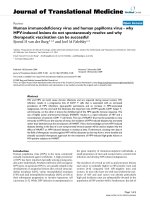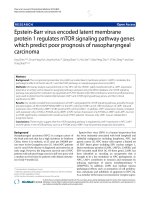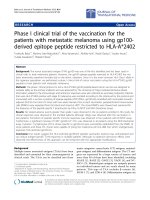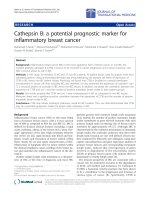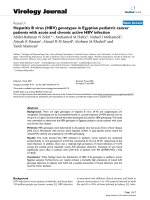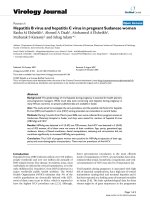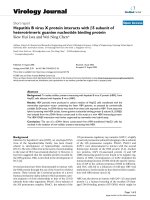Báo cáo hóa học: " Hepatitis B virus (HBV) genotypes in Egyptian pediatric cancer patients with acute and chronic active HBV infection" ppt
Bạn đang xem bản rút gọn của tài liệu. Xem và tải ngay bản đầy đủ của tài liệu tại đây (316.12 KB, 7 trang )
BioMed Central
Page 1 of 7
(page number not for citation purposes)
Virology Journal
Open Access
Research
Hepatitis B virus (HBV) genotypes in Egyptian pediatric cancer
patients with acute and chronic active HBV infection
Abdel-Rahman N Zekri*
1
, Mohamed M Hafez
1
, Nahed I Mohamed
2
,
Zeinab K Hassan
1
, Manal H El-Sayed
3
, Mohsen M Khaled
4
and
Tarek Mansour
1
Address:
1
Virology and Immunology Unit, Cancer Biology Department, National Cancer Institute, Cairo University, 1st Kasr El-Aini st, Cairo,
Egypt,
2
Microbiology Department, Faculty of Medicine, Suez Canal University, Ismailia, Egypt,
3
Pediatric Department, Faculty of Medicine, Ain
Shams university, Abbasya, Cairo, Egypt and
4
National Diabetes Institute, Ministry of Health, Egypt, 1st Kasr El-Aini st., Cairo, Egypt
Email: Abdel-Rahman N Zekri* - ; Mohamed M Hafez - ;
Nahed I Mohamed - ; Zeinab K Hassan - ; Manal H El-Sayed - ;
Mohsen M Khaled - ; Tarek Mansour -
* Corresponding author
Abstract
Background: There are eight genotypes of hepatitis B virus (A-H) and subgenotypes are
recognized. Genotyping can be accomplished based on a partial sequence of HBV genome such as
the pre-S or S gene. Several methods have been developed and used for HBV genotyping. This study
was undertaken to determine the HBV genotypes in Egyptian pediatric cancer patients with acute
and chronic liver disease.
Methods: HBV genotypes were determined in 22 patients who had acute forms of liver disease
(AH) and in 48 patients with chronic active hepatitis (CAH). A type-specific primer based the
nested-PCR method was employed in the HBV genotyping.
Results: This study showed that HBV infections in pediatric cancer patients are attributed
predominantly to viral genotypes D and B that constituted 37.1% and 25.7%, respectively of the
total infections. In addition, there was a relatively high prevalence of mixed infections of 15.7%
among the studied group especially mixed A/D genotype infections. Genotype D was found
significantly more often in patients with CAH than in patients with AH [23/48(47.9%) v 3/22
(13.6%)].
Conclusion: These findings show the distribution of HBV A-D genotypes in pediatric cancer
Egyptian patients. Furthermore, our results indicate a markedly high prevalence of mixed A/D
genotype infections in subjects with CAH and a possible association of mixed infections with the
severity of liver diseases.
Background
HBV infection is very common worldwide, and more than
350 million people are chronic carriers [1]. HBV infection
is associated with different clinical pictures and leads to
chronic carrier state in 5 to 10% patients infected in adult
life and 85 to 90% of those infected in infancy [2]. Infec-
Published: 15 July 2007
Virology Journal 2007, 4:74 doi:10.1186/1743-422X-4-74
Received: 9 June 2007
Accepted: 15 July 2007
This article is available from: />© 2007 Zekri et al; licensee BioMed Central Ltd.
This is an Open Access article distributed under the terms of the Creative Commons Attribution License ( />),
which permits unrestricted use, distribution, and reproduction in any medium, provided the original work is properly cited.
Virology Journal 2007, 4:74 />Page 2 of 7
(page number not for citation purposes)
tion with HBV can also lead to progressive liver disease,
including liver cirrhosis and hepatocellular carcinoma
(HCC) with approximately 1 million HBV-associated
deaths from HCC every year [3].
HBV was formerly classified into four different subtypes
that were afterward subdivided according to the antigenic
determinants of HBsAg in adw (adw2 and adw4), ayw
(ayw1, ayw2, ayw3, and ayw4), adr (adrq+ adrq-), and ayr
[4].
Another classification reflecting the phylogenetic origin of
the virus isolates was later proposed dividing HBV into six
genotypes designated A to F. These genotypes were differ-
entiated by a sequence divergence in the entire genome
exceeding 8% [5]. Seventh and eighth genotypes were
reported: genotype G, which has an insertion of 36 nucle-
otides (nt) in the core gene and was discovered in France
and United States [6], and genotype H, which was found
in Nicaragua, Mexico, and California and has probably
split off from genotype F within the New World [7].
Therefore, eight genotypes of HBV (A-H) are currently rec-
ognized, and subgenotypes have recently been described
which differ by at least 4% [8]. The genotypes show a dis-
tinct geographical distribution between and even within
regions, and are proving to be an invaluable tool in trac-
ing the molecular evolution and patterns and modes of
spread of HBV. Structural and functional differences
between genotypes can influence the severity, course and
likelihood of complications, hepatitis B e antigen
(HBeAg) seroconversion and response to treatment of
HBV infection and possibly vaccination against the virus
[9]. Although the number of studies on these genotypes
has increased dramatically during recent years, much
remains to be learnt about their full implications.
Africa is one of the highly endemic regions of HBV, with
5 genotypes A-E identified. Genotype A in Kenya [10],
genotype D in Tunisia [11], genotype A-D in South Africa
[12] and genotype E in Nigeria [13] were reported as pre-
dominant genotypes in these countries. Apart from these
reports, however, there is little information of genotype
distribution in Africa despite the importance of this infec-
tion in this region.
Few reports described the frequency of HBV genotypes in
Egypt. In one study, the genotypes of HBV isolated from
105 serum samples from Egyptian carriers were deter-
mined by sequencing and found that HBV genotype D are
most prevalent in Egypt [14]. Naito et al. (2001) exam-
ined 2 serum samples positive for HBV DNA by primer
specific PCR and these turned to be of genotype D [15].
HBV genotyping may evolve from a research tool into
being an essential clinical diagnostic test, very much as
HCV genotyping did. One hurdle in the introduction of
HBV genotyping to clinical practice is the lack of a simple,
rapid, and accurate test [16]. Currently, HBV genotypes
can be determined by several methods, including direct
sequencing [6], restriction fragment length polymor-
phism analysis [17], line-probe assay [18], PCR using
type-specific primers [15], colorimetric point mutation
assay [19], ligase chain reaction assay [20], and enzyme-
linked immunosorbent assay for genotype-specific
epitopes [10]. Direct sequencing is the most accurate and
permits detection of the common as well as uncommon
mutations but is also the most expensive and tedious [16].
Development of rapid, simple, and standardized assays
that can detect all known genotypes can accelerate
progress in research on the clinical significance of HBV
genotypes.
The aim of this study was to investigate the frequency of
HBV genotypes in Egyptian patients by PCR using type-
specific primers.
Patients and methods
Patients
The study was approved by ethical committee and
informed consents were obtained from all parents of each
patients participating in the study. This study included 70
pediatric cancer patients (38 males and 32 females)
attending the National Cancer Institute (NCI), Cairo Uni-
versity suffering from hepatitis and were diagnosed as
HBV infection. HBV was diagnosed based on clinical data,
liver function tests, HBV serum markers and HBV DNA by
PCR. Serum samples were collected from patients in a
period between December 2005 to January 2007 and
stored at -20°C until used.
The age of the patients ranged from 3 years to 18 years
(mean, 10.5). The study group comprised 22 patients with
acute hepatitis B infection (AH) and 48 with chronic
active hepatitis (CAH). HBV related acute forms of liver
disease were diagnosed based on the appearance of hepa-
titis B surface antigen (HBsAg) and the presence of anti-
HBc-IgM. Patients who had HBsAg for more than 6
months with an abnormal alanine aminotransferase
(ALT) level and the presence of anti-HBc-IgG were diag-
nosed as CAH. All patients were HBeAg positive.
Serological markers
Serologic markers for HBV (hepatitis B surface antigen
[HBsAg], hepatitis Be antigen [HBeAg] and antibodies to
hepatitis B core antigen [anti-HBc]) (enzyme immu-
noassay [EIA]; Adaltis, Italy) infection were detected with
current standard assay. All serologic assays were carried
out according to the manufacturer's instructions.
Virology Journal 2007, 4:74 />Page 3 of 7
(page number not for citation purposes)
DNA extraction
The QIAamp DNA extraction kit (QIAGEN GmbH,
Hilden Germany) was employed for DNA extraction from
serum samples according to the manufacturer's instruc-
tions.
Serum HBV DNA detection
All DNA extracts were analyzed for HBV genomes with
polymerase chain reaction (PCR) assays to detect the core
genes, according to previously described methods [21].
Briefly, 100 µl of reaction mixture containing 10 µl of
extracted DNA, 50 mM potassium chloride, 10 mM TRIS-
hydrochloric acid (pH 8.3), 2 mM magnesium chloride,
200 µM deoxyribonucleosides, 2.5 U of Taq polymerase
(Perkin-Elmer Cetus, Norwalk, Conn.), and 20 pmol each
of the oligonucleotide primers C1 sense CTGGGAG-
GAGTTGGGGGA (1730–1747) and C2 antisense GTA-
GAAGAATAAAGCCC (2503–2487) for the core gene.
Amplification was performed for one cycle at 95°C for 5
min followed by 35 cycles, each consisting of denaturing
for 1 min. at 94°C, annealing for 1 min at 55°C, and
extension for 1.5 minutes at 72°C. The amplification
products were visualized on an ethidium bromide-stained
2% agarose gel (fig 1).
Genotype analysis
A genotyping system based on PCR using type-specific
primers was used in this study for the determination of
genotypes A through F of hepatitis B virus according to
previously described methods by Naito et al. 2001[15].
The sequences of PCR primers used in this study are
shown in Table 1. The first round PCR primers and sec-
ond-round PCR primers were designed on the basis of the
conserved nature of nucleotide sequences in regions of the
pre-S1 through S genes, irrespective of the six HBV geno-
types [15]. P1 (sense) and S1-2 (antisense) were universal
outer primers (1,063 bases). B2 was used as the inner
primer (sense) with a combination called mix A for geno-
types A, B, and C. Mix A consisted of antisense primers
BA1R (type A specific), BB1R (type B specific), and BC1R
(type C specific). B2R was used as the inner primer (anti-
sense) with a combination called mix B for genotypes D,
E, and F. Mix B consisted of sense primers BD1 (type D
specific), BE1 (type E specific), and BF1 (type F specific).
These primer combinations for second-round PCR were
designed on the basis of the differences in the sizes of the
genotype-specific bands. The type-specific primers were
designed on the basis of the conserved nature of those
sequences within a genotype and on the basis of their
poor homology with the sequences derived from other
HBV genotypes [15]. The first PCR was carried out in 40 ul
of a reaction mixture containing 100 ng of each outer
primer, a 200 mM concentration of each of the four deox-
ynucleotides, 2.5 U of Taq DNA polymerase (Promega,
France) 1× PCR buffer containing containing (50 mM
KCl, 10 mM Tris pH 8.3) and 1.5 mM MgCl2. The thermo-
cycler (Eppendorf, Germany) was programmed to first
incubate the samples for 5 min at 95°C, followed by 40
cycles consisting of 94°C for 1 min, 55°C for 1 min and
72°C for 2 min. Two second-round PCRs were performed
for each sample, with the common universal sense primer
(B2) and mix A for types A through C and the common
universal antisense primer (B2R) and mix B for types D
through F. A 1 ml aliquot of the first PCR product was
added to two tubes containing the second sets of each of
the inner primer pairs, each of the deoxynucleotides, Taq
DNA polymerase, and PCR buffer, as in the first reaction.
These were amplified for 40 cycles with the following
parameters: preheating at 95°C for 5 min, 30 cycles of
amplification at 94°C for 1 min, 58°C for 1 min, and
72°C for 1.30 min Genotypes of HBV for each sample
were determined by identifying the genotype-specific
DNA bands. The two different second-round PCR prod-
ucts from one sample were visualized on an ethidium bro-
mide-stained 3% agarose gel. The sizes of PCR products
were estimated according to the migration pattern of a 50
lane PCR marker (Promega, Madison, WIs.).
Statistical analysis
Analysis of data was carried out with the aid of SPSS pack-
age version 10.0. Parameters were compared using the
Chi-square test. P values less than 0.05 were considered
statistically significant.
Results
Distribution of HBV genotypes
This study showed that HBV infections in pediatric cancer
patients are attributed predominantly to viral genotypes D
and B that constituted 37.1% and 25.7%, respectively of
the total infections. In addition, there was a relatively high
prevalence of mixed infections of 15.7% among the stud-
DNA amplification by PCR using conserved nature of nucle-otide sequences in regions of the pre-S1 through S genes fol-lowed by gel electrophoresis, ethidium bromide staining lanes 1–5 represent positive cases for genotype C, lanes 6–10 represent positive cases for genotype D and lane 11 is PCR marker (Promega, Madison, Wis. USA)Figure 1
DNA amplification by PCR using conserved nature of nucle-
otide sequences in regions of the pre-S1 through S genes fol-
lowed by gel electrophoresis, ethidium bromide staining
lanes 1–5 represent positive cases for genotype C, lanes 6–
10 represent positive cases for genotype D and lane 11 is
PCR marker (Promega, Madison, Wis. USA).
1 2 3 4 5 6 7 8 9 10 11
Virology Journal 2007, 4:74 />Page 4 of 7
(page number not for citation purposes)
ied group. HBV genotypes A and C infections were the
least observed and constituted 10% and 8.6% respectively
of the total infections (fig 2). Two cases were not confined
to any of the six genotypes studied (2.9%). No HBV gen-
otype E or F was found in our study and furthermore, gen-
otypes G and H were not determined.
Association between liver disease and the prevalence of
HBV genotypes
The distribution of HBV genotypes in the various forms of
liver disease is shown in table 2. Among the 22 patients
who had an acute form of liver disease, genotype B
showed a predominance over the other genotypes with
the following values respectively: 2 cases (9%) genotype
A, 10 (45.5%) genotype B, 3 (13.6%) genotype C and 3
(13.6%) genotype D. In subjects with CAH (48 cases), the
distribution of genotype A, B, C and D infections were as
follows: 5 (10.4%), 8 (16.7%), 3 (6.3%), 23 (47.9%)
respectively, with a predominance of genotype D. Geno-
type D was found significantly more often in patients with
CAH than in patients with AH [23/48(47.9%) v 3/22
(13.6%)]. Also, genotype A tended to be found more
often in patients with CHD than in patients with AH [5/
48 (10.4%) v 2/22 (9%)] (P < 0.05).
Distribution of mixed HBV genotypes
Another finding in this study was the presence of 11 cases
(15.7%) with mixed genotype infections. Five cases had
both genotypes A and D, 2 cases had C and D, 2 other
cases had B and D and 2 cases had genotypes B and C. The
distribution of mixed genotypes among AH and CAH
patients is shown in figure 3. CAH patients showed a
higher prevalence of mixed genotypes than AH patients
(7/11 (63.3%) v 4/11 (36.3%) (Table 2). The comparative
mixed infections between the two groups were statistically
insignificant.
Discussion
HBV is a typical example of a virus that attracts attention
with its different genotypes, showing special geographic
distribution around the world. A genetic classification
based on the comparison of complete genomes has
defined eight genotypes of HBV, which were designated
from A through H [5-7]. Genotype D appears to predom-
inate in the Mediterranean basin and the Middle East, and
Table 2:
Subjects N = 70 HBV genotypes
ABCDmixed
Acute hepatitis (22) 2 (9%) 10 (45.5%) 3 (13.6%) 3 (13.6%) 4 (18.2%)
Chronic* active hepatitis (48) 5 (10.4%) 8 (16.7%) 3 (6.3%) 23 (47.9%) 7 (14.6%)
Total 7 (10%) 18(25.7%) 6 (8.6%) 26 (37.1%) 11 (15.7%)
*Two CAH cases were non A to F
HBV genotype distribution in the studied groupFigure 2
HBV genotype distribution in the studied group.
10%
25.70%
8.60%
37.10%
15.70%
2.90%
A
B
C
D
MIXED
non A to F
Table 1:
Primer Sequence
a
(position, specificity, and polarity)
First PCR
P1 5'-TCA CCA TAT TCT TGG GAA CAA GA-3'
(nt 2823–2845, universal, sense)
S1-2 5'-CGA ACC ACT GAA CAA ATG GC-3'
(nt 685–704, universal, antisense)
Second PCR
Mix A
B2 5'-GGC TCM AGT TCM GGA ACA GT-3'
(nt 67–86, types A to E specific, sense)
BA1R 5'-CTC GCG GAG ATT GAC GAG ATG T-3'
(nt 113–134, type A specific, antisense)
BB1R 5'-CAG GTT GGT GAG TGA CTG GAG A-3'
(nt 324–345, type B specific, antisense)
BC1R 5'-GGT CCT AGG AAT CCT GAT GTT G-3'
(nt 165–186, type C specific, antisense)
Mix B
BD1 5'-GCC AAC AAG GTA GGA GCT-3'
(nt 2979–2996, type D specific, sense)
BE1 5'-CAC CAG AAA TCC AGA TTG GGA CCA-3'
(nt 2955–2978, type E specific, sense)
BF1 5'-GYT ACG GTC CAG GGT TAC CA-3'
(nt 3032–3051, type F specific, sense)
B2R 5'-GGA GGC GGA TYT GCT GGC AA-3'
(nt 3078–3097, types D to F specific, antisense)
a
An "M" represents a nucleotide that could be either an A or a C; a
"Y" represents a nucleotide that could be either a C or a T. nt:
nucleotide.
Virology Journal 2007, 4:74 />Page 5 of 7
(page number not for citation purposes)
this is consistent with Egypt's geographical location in the
world.
The genotyping of HBV is important to clarify the route
and pathogenesis of the virus. In particular, the examina-
tion of sequence diversity among different isolates of the
virus is important, because variants may differ in their pat-
terns of serologic reactivity, pathogenicity, virulence, and
response to therapy [4,22].
Several methods have been developed and used for HBV
genotyping including direct sequencing [6], PCR based
restriction fragment length polymorphism [17], line
probe assay [18] and enzyme-linked immunoassay [10].
Recently a new genotyping method, based on PCR ampli-
fication assay using type-specific primers, which can iden-
tify all six major genotypes has been developed by Naito
et al. [15]. We employed this handy, convenient and novel
type-specific primer based PCR method in this study to
investigate the prevalence of HBV genotypes in Egyptian
pediatric cancer patients concomitantly infected with
HBV.
Few reports described the frequency of HBV genotypes in
Egypt. In this study, genotype D was reported as the pre-
dominant HBV genotype in the study subjects (37.1%)
followed by genotype B that constituted 25.7%. These fig-
ures are in conformity with 2 other studies done in Egypt.
In one study, the genotypes of HBV isolated from 105
serum samples from Egyptian carriers were determined by
sequencing and found that HBV genotype D are most
prevalent in Egypt [14]. Naito et al. (2001) examined 2
serum samples positive for HBV DNA by primer specific
PCR and these turned to be of genotype D but they didn't
find other genotypes as they only examined 2 serum sam-
ples [15].
Another similar study was done in Turkey, a country in the
Middle East, to determine the hepatitis B virus genotypes
in Turkish patients with chronic liver disease. Their study
comprised 25 pediatric and 29 adult patients with chronic
hepatitis B virus infection and genotype D was the domi-
nant genotype in all of their cases [23].
Genotype D was found significantly more often in
patients with CAH than in patients with AH (P < 0.05).
Previous reports have indicated that genotype C was the
predominant genotype in subjects with advanced chronic
hepatitis (CH), liver cirrhosis (LC) and hepatocelluler car-
cinoma (HCC) [24,25] in contrast to our results. How-
ever, the number of patients for each pattern was
insufficient to reach firm conclusions. Two reports from
India have provided conflicting results in this context. In
a study of chronic carriers in which, surprisingly, 50% of
the patients were infected with genotype A strains and
50% were infected with genotype D strains, Thakur et al.
[26] found that patients infected with genotype D strains
had more severe chronic liver disease. In contrast, Gandhe
et al. [27] could not find that genotype D influenced the
outcome of chronic HBV infection in Indian patients. In
another study, Ljunggren et al. [3] found that HBV geno-
type D may be associated with more active disease.
The distribution of HBV genotype B in acute forms of liver
disease was higher than that seen in chronic forms of the
disease suggesting an association of genotype B with more
severe acute forms of liver disease. A similar result was
observed in the study of Imamura et al. [28] that showed
that genotype B was more prevalent in patients with FH
and AH. They attributed this result to the possibility that
Genotype B virus may have the motifs that strongly bind
to HLA class I molecules, thereby resulting in activation of
a stronger immune response and a more liver damage.
Double infections with two different HBV genotypes have
been known since typing was done serologically [29].
Subsequently, evidence of super infection with HBV iso-
lates of the same or different genotype was described in
chronic HBV patients [30]. Super infection was accompa-
nied by acute exacerbation of the chronic disease. Using
different methods for genotyping, several reports
described high rates of double infection with two different
HBV genotypes in all parts of the world. Using these meth-
ods double infections have been found in a range from
4.4% [31] to 17.5% [32] of HBV infected patients. Even
triple infections with HBV of genotype A, B and C have
been described in 0.9% of HBV infected intravenous drug
users [32].
Distribution of mixed genotypes among the study groupsFigure 3
Distribution of mixed genotypes among the study groups.
0
1 1
2
5
1 1
0
0
1
2
3
4
5
6
A+D C+D B+D B+C
Mixed genotypes
No. of cases
CAH
AH
Virology Journal 2007, 4:74 />Page 6 of 7
(page number not for citation purposes)
In this study, we reported a prevalence of mixed genotype
infections in study subjects of 15.7% especially those with
CAH. HBV genotype A and D mixed infections accounted
for 45.5% of the total mixed infections. We conclude that
HBV mixed genotype infections could probably be of clin-
ical significance in HBV-induced liver diseases. In light of
the prevalence of mixed A/D genotype infections in our
study, we propose that greater attention be paid to A/D
mixed genotype screening in the management of HBV-
induced chronic liver diseases and evaluation of therapy.
We therefore suggest that HBV genotyping become a rou-
tine exercise in clinical medicine and molecular epidemi-
ology. As genotypes have different biological and
epidemiological behavior, their detection and monitoring
is more than just academic but also medically significant.
Furthermore, efforts to prevent mixed infections (super-
infection or co-infections) in patients with chronic hepa-
titis B should not be overlooked, especially in areas
endemic for HBV infection. Since a small number of sub-
jects were employed in our investigation, we propose that
large scale studies be conducted to substantiate our find-
ings. Such studies could also provide more insight into the
association between co-infection and disease exacerba-
tions as well as shed lighter on the molecular, virological
and host mechanisms underlying the pathogenesis of
HBV-related disease.
Competing interests
The author(s) declare that they have no competing inter-
ests.
Authors' contributions
A-R N Z: Conceived of the study, participated in its design
and coordination, drafted the manuscript and coordinate
the whole work team.
M M H: Sample collection, carried out the molecular gen-
otyping studies, participated in the drafted the manuscript
and performed the statistical analysis.
N I M: participated in the editing of the manuscript.
Z K H: sample collection and carried out the serological
assays.
M H E: Responsible for the patient treatment and clinical
data collection
M M K: participated in the editing the manuscript and
clinical data.
T M: Coordinated the research effort.
All eight co-authors read and approved the final manu-
script.
References
1. Lee WM: Hepatitis B virus infection. N Engl J Med 1997,
337:1733-1745.
2. Gust I, Crowe S: The global importance of viral hepatitis. Clin
Trop Med Commun Dis 1986, 1:281-301.
3. Ljunggren K, Myhre E, Bläckberg J: Clinical and Serological Vari-
ation between Patients Infected with Different Hepatitis B
Virus Genotypes. J Clin Microbiol 2004, 42:5837-5841.
4. Neurath AR, Thanavala Y: Immunochemistry of viruses. II. The
basis for serodiagnosis and vaccines. In Hepadnaviruses Edited
by: Van Regenmortel MHV, Neurath AR. Elsevier, Amsterdam, the
Netherlands; 1990:403-458.
5. Norder H, Courouce AM, Magnius LO: Complete genomes, phy-
logenic relatedness and structural proteins of six strains of
the hepatitis B virus, four of which represent two new geno-
types. Virology 1994, 198:489-503.
6. Stuyver L, De Gendt S, Van Geyt C, Zoulim F, Fried M, Schinazi RF,
Rossau R: A new genotype of hepatitis B virus: complete
genome and phylogenetic relatedness. J Gen Virol 2000,
81:67-74.
7. Arauz-Ruiz , Norder PH, Robertson BH, Magnius LO, Genotype H: A
new Amerindian genotype of hepatitis B virus revealed in
Central America. J Gen Virol 2002, 83:2059-2073.
8. Norder H, Courouce AM, Coursaget P, Echevarria JM, Leef SD,
Mushahwar IK, Robertson BH, Locarnini S, Magnius LO: Genetic
Diversity of Hepatitis B Virus Strains Derived Worldwide:
Genotypes, Subgenotypes, and HBsAg Subtypes. Intervirology
2004, 47:289-309.
9. Chu CJ, Lok ASF: Clinical significance of hepatitis B virus gen-
otypes. Hepatology 2002, 35:1274-1276.
10. Usuda SH, Okamoto H, Iwanari K, Baba F, Tsuda Y, Miyakawa Mayumi
M: Serological detection of hepatitis B virus genotypes by
ELISA with monoclonal antibodies to type-specific epitopes
in the preS2-region product. J Virol Methods 1999, 80:97-112.
11. Borchani-Chabchoub I, Gargouri A, Mokdad-Gargouri R: Genotyp-
ing of Tunisian hepatitis B virus isolates based on the
sequencing of preS2 and S regions. Microbes Infect 2000,
2:607-612.
12. Bowyer SM, VanStaden L, Kew MC, Sim JG: A unique segment of
the hepatitis B virus group A genotype identified in isolates
from South Africa. J Gen Virol 1997, 78:1719-1729.
13. Odemuyiwa SO, Mulders MN, Oyedele OI, Ola SO, Odaibo GN, Ola-
leye DO, Muller CP: Phylogenetic analysis of new hepatitis B
virus isolates from Nigeria supports endemicity of genotype
E in West Africa. J Med Virol 2001, 65:463-469.
14. Saudy N, Sugauchi F, Tanaka Y, Suzuki S, Aal A, Zaid MA, Agha S,
Mizokami M: Genotypes and phylogenetic characterization of
hepatitis B and delta viruses in Egypt. J Med Virol 2003,
70(4):529-36.
15. Naito H, Havashi S, Abe K: Rapid and specific genotyping system
for hepatitis B virus corresponding to six major genotypes by
PCR using type-specific primers. J Clin Microbiol 2001,
39(4):1686.
16. Hussain M, Chu C, Sablon E, Lok ASF: Rapid and Sensitive Assays
for Determination of Hepatitis B Virus (HBV) Genotypes
and Detection of HBV Precore and Core Promoter Variants.
J Clin Microbiol 2003, 41:3699-3705.
17. Mizokamia M, Nakanob T, Oritob E, Tanakab Y, Sakugawac H, Mukai-
ded M, H Robertsone B: Hepatitis B virus genotype assignment
using restriction fragment length polymorphism patterns.
FEBS Letters 1999, 450:66-71.
18. Grandjacques C, Pradat P, Stuyver L, Chevallier M, Chevallier P,
Pichoud C, Maisonnas M, Trepo C, Zoulim F: Rapid detection of
genotypes and mutations in the pre-core promoter and the
pre-core region of hepatitis B virus genome: correlation with
viral persistence and disease severity. J Hepatol 2000,
33:430-439.
19. Ballard AL, Boxall EH: Colourimetric point mutation assay: for
detection of precore mutants of hepatitis B. J Virol Methods
1997, 67:143-152.
Publish with Bio Med Central and every
scientist can read your work free of charge
"BioMed Central will be the most significant development for
disseminating the results of biomedical research in our lifetime."
Sir Paul Nurse, Cancer Research UK
Your research papers will be:
available free of charge to the entire biomedical community
peer reviewed and published immediately upon acceptance
cited in PubMed and archived on PubMed Central
yours — you keep the copyright
Submit your manuscript here:
/>BioMedcentral
Virology Journal 2007, 4:74 />Page 7 of 7
(page number not for citation purposes)
20. Minamitani S, Nishiguchi S, Kuroki T, Otani S, Monna T: Detection
by ligase chain reaction of precore mutant of hepatitis B
virus. Hepatology 1997, 25:216-222.
21. Kao JH, Chen PJ, Lai MY, Chen DS: Occult hepatitis B virus infec-
tion and clinical outcomes of patients with chronic hepatitis.
C J Clin Microbiol 2002, 40(11):4068-71.
22. Okamoto H, Tsuda F, Sakugawa H, Sastrosoewignjo RI, Imai M, Miya-
kawa Y, Mayumi M: Typing hepatitis B virus by homology in
nucleotide sequence: comparison of surface antigen sub-
types. J Gen Virol 1988, 69:2575-2583.
23. Özdemir FT, Duman D, Ertem D, Avsar E, Eren F, Özdogan O, Kalay-
aci C, Aslan N, Bozdayi AM, Tozun N: Determination of hepatitis
B genotypes in patients with chronic hepatitis B virus infec-
tion in Turkey. The Turkish Journal of Gastroenterology 2005,
16:183-187.
24. Orito E, Mizokami M, Sakugawa H, Michitaka K, Ishikawa K, Ichida T,
Okanoue T, Yotsuyanagi H, Iino S: A case-control study for clini-
cal and molecular biological differences between hepatitis B
viruses of genotypes B and C. Hepatology 2001, 33:218-223.
25. Kao J, Chen HPJ, Lai MY, Chen DS: Clinical and virological
aspects of blood donors infected with hepatitis B virus geno-
types B and C. J Clin Microbiol 2002, 40:22-25.
26. Thakur V, Guptan RC, Kazim SN, Malhotra V, Sarin SK: Profile,
spectrum and significance of HBV genotypes in chronic liver
disease patients in the Indian subcontinent. J Gastroenterol
Hepatol 2002, 17:165-170.
27. Gandhe S, Chadha SMS, Arankalle VA: Hepatitis B virus geno-
types and serotypes in western India: lack of clinical signifi-
cance. J Med Virol 2003, 69:324-330.
28. Imamura T, Yokosuka O, Kurihara T, Kanda T, Fukai K, Imazeki F,
Saisho H: Distribution of hepatitis B viral genotypes and
mutations in the core promoter and precore regions in
acute forms of liver disease in patients from Chiba, Japan.
Gut 2003, 52:1630-1637.
29. Tabor E, Gerety RJ, Smallwood LA, Barker LF: Coincident hepatitis
B surface antigen and antibodies of different subtypes in
human serum. J Immunol 1977, 118:369-370.
30. Kao J, Chen HPJ, Lai MY, Chen DS: Acute exacerbations of
chronic hepatitis B are rarely associated with superinfection
of hepatitis B virus. Hepatology 2001, 34:817-823.
31. Ding X, Gu H, Zhong ZH, Zilong X, Tran HT, waki Y, Li TC, Sata T,
Abe K: Molecular epidemiology of hepatitis viruses and geno-
typic distribution of hepatitis B and C viruses in Harbin,
China. Jpn J Infect Dis 2003, 56:19-22.
32. Chen B, Kao FJH, Liu CJ, Chen DS, Chen PJ: Genotypic dominance
and novel recombinations in HBV genotype B and C coin-
fected intravenous drug users. J Med Virol 2004, 73:13-22.


